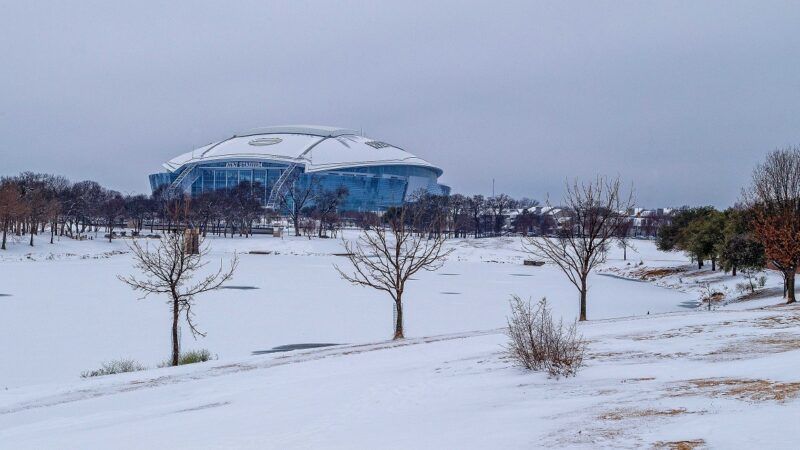The Texas Blackout Blame Game
Neither wind power nor deregulation are responsible for the Texas power disaster.

"If I owned Texas and Hell," Gen. Philip Sheridan once said, "I would rent out Texas and live in Hell." He probably was thinking about our hot summers, but after last week Hell's central heating is starting to seem appealing. Millions of Texans were left without electricity, heat, and in some cases water service.
The Texas blackouts are shaping up to be the costliest disaster in state history, and the loss of life remains unknown. People are justifiably very angry. And when people are angry, politicians look around for someone to blame. Many have trotted out their favorite villains for the occasion. Many on the right have picked Don Quixote's old enemy, the windmill, while many on the left jumped at the chance to blame deregulation. Neither explanation really holds up. While it will be some time before all the specifics are known, what we do know doesn't support any easy political narrative.
The central fact about the chain of events that led to the blackouts is deceptively simple: It got super cold.
In order to keep the lights on, electric generation must match demand on a minute-by-minute basis. For that reason, the system's planners and forecasters focus their attention on the times of the year when demand is typically highest. In Texas, that's the heat of summer. Many features of our electric grid are designed to work optimally during the summer, with the understanding that in the winter we will usually have far more electric capacity that we need.
The state was not prepared for record cold temperatures stretching across all 254 Texas counties. This generated summer levels of electric demand, and it also caused significant amounts of generation to become unusable. Because really cold temperatures are rare in Texas, many plants contain components that are not protected from the elements. This is true for generators of all fuel types, from wind to nuclear. In addition, Texas typically relies heavily on natural gas to meet its peak electric demand, as natural gas plants are easier to ramp up or down on short notice. During the summer that's not a problem. In the winter, though, gas is also used for heating, and many gas plants did not have firm contracts to deliver fuel and had trouble buying it on the open market. Finally, the winter is a time when some plants shut down for scheduled maintenance.
The result: In the early morning hours of February 15, the state's grid operator—the Electric Reliability Council of Texas, or ERCOT—found itself facing a supply shortfall with more than a third of the grid's thermal generation capacity (natural gas, coal, and nuclear) unusable. To prevent total system failure, ERCOT ordered utilities to curtail service, plunging millions of homes into darkness and cold.
The sheer size of the supply hole makes it hard to blame either wind or deregulation for the failure. While pictures of frozen wind turbines may be evocative, ERCOT's forecasts do not rely on a large amount of wind to sustain the system—and wind ended up meeting those expectations. Some have argued that the low cost of wind power over the last decade has forced the retirement of more reliable power plants that could have helped make up the gap had they been there. I've addressed those arguments at length elsewhere; here I'll add that many of the recently retired Texas plants were rendered unprofitable not by wind but by the fracking-induced fall in natural gas prices. And given how many thermal plants failed, it doesn't seem plausible that having a few more of them would have made the difference.
Similarly, there is little reason to think that Texas' competitive electric system is to blame. ERCOT's most recent winter forecast included a worst-case scenario for the grid that roughly predicted the needed demand but underestimated the amount of generation that would be unusable by almost half. A more centralized or state-run electric system almost certainly would have relied on the same forecast and ended up in the same situation. In retrospect, it's easy to blame generators for not doing more to protect their plants from cold. But if a plant had known that unprecedented cold was coming and had weatherized, it would now be reaping millions in benefits. The problem was not a lack of incentives but a lack of imagination.
One outstanding question has to do with the fact that Texas maintains its own separate electric grid (the rest of the continental United States is split between an eastern and western grid). This has given the state more control over electric policy, and the state is large enough that historically not being part of a larger grid has not been a problem. Would Texas have been able to avoid its problems if it had been part of one of these larger interconnects? So far I don't think we have the data to answer this question one way or the other. In theory, a larger geography should help, and while neighboring states also had to resort to rolling blackouts, they did not do so on nearly the same scale. However, I've yet to see any detailed analysis of whether being part of a larger system would have reduced the overall number of outages or simply spread them out over a greater area.
That's not a very satisfying answer, and I'm sure that there are many decisions made in the days and years leading up to the blackouts that will and should be second-guessed. But fundamentally the blackouts happened because across the entire system, people did not anticipate how bad things could get. It was a failure to expect the unexpected.


Show Comments (292)